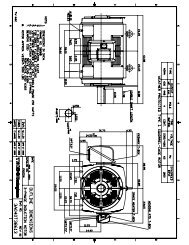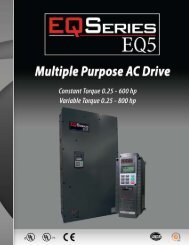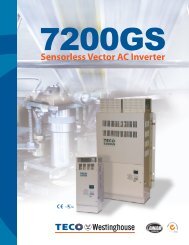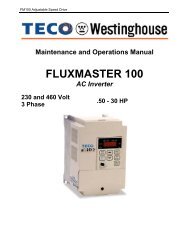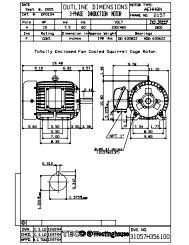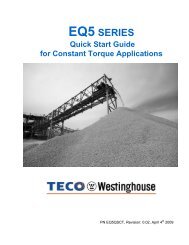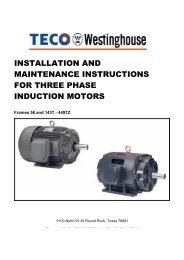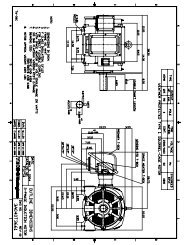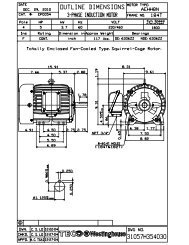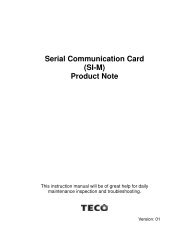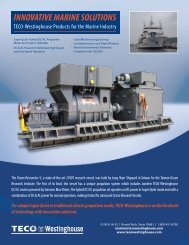EQ7 Series Instruction Manual - TECO-Westinghouse Motor Company
EQ7 Series Instruction Manual - TECO-Westinghouse Motor Company
EQ7 Series Instruction Manual - TECO-Westinghouse Motor Company
You also want an ePaper? Increase the reach of your titles
YUMPU automatically turns print PDFs into web optimized ePapers that Google loves.
Possible Causes<br />
(8) A frequency command with<br />
higher priority than the one<br />
attempted was active.<br />
(9) The upper and lower<br />
frequencies for the frequency<br />
limiters were set incorrectly.<br />
(10) The coast-to-stop command<br />
was effective.<br />
(11) Broken wires, incorrect<br />
connection or poor contact with<br />
the motor.<br />
What to Check and Suggested Measures<br />
Check the higher priority run command with Menu #2 "Data Checking" and<br />
Menu #4 "I/O Checking" using the keypad, referring to the block diagram of<br />
the frequency command block (refer to the <strong>EQ7</strong> User's <strong>Manual</strong>, Chapter 6).<br />
Correct any incorrect function code data (e.g. cancel the higher priority run<br />
command).<br />
Check the data of function codes F15 (Frequency limiter (High)) and F16<br />
(Frequency limiter (Low)).<br />
Change the settings of F15 and F16 to the correct ones.<br />
Check the data of function codes E01 through E07, E98, and E99 and the<br />
input signal status, using Menu #4 "I/O Checking" on the keypad.<br />
Release the coast-to-stop command setting.<br />
Check the wiring (Measure the output current).<br />
Repair the wires to the motor, or replace them.<br />
(12) Overload Measure the output current.<br />
Reduce the load (In winter, the load tends to increase.)<br />
(13) Torque generated by the motor<br />
was insufficient.<br />
(14) Wrong connection or poor<br />
contact of DC reactor (DCR)<br />
[ 2 ] The motor rotates, but the speed does not increase.<br />
Check whether any mechanical brake is activated.<br />
Release the mechanical brake, if any.<br />
Check that the motor starts running if the value of torque boost (F09*) is<br />
increased.<br />
Increase the value of torque boost (F09*) and try to run the motor.<br />
Check the data of function codes F04*, F05*, H50, H51, H52, H53, H65, and<br />
H66.<br />
Change the V/f pattern to match the motor's characteristics.<br />
Check that the motor switching signal (selecting motor 1, 2, 3 or 4) is correct<br />
and the data of function codes matches each motor.<br />
Correct the motor switching signal.<br />
Modify the function code data to match the connected motor.<br />
Check whether the reference frequency is below the slip-compensated<br />
frequency of the motor.<br />
Change the reference frequency so that it becomes higher than the<br />
slip-compensated frequency of the motor.<br />
Check the wiring.<br />
Inverters of 100 HP or above require a DCR to be connected. Without a DCR,<br />
these inverters cannot run.<br />
Connect the DCR correctly. Repair or replace DCR wires.<br />
Possible Causes<br />
(1) The maximum frequency<br />
currently specified was too low.<br />
(2) The data of frequency limiter<br />
(High) currently specified was<br />
too low.<br />
(3) The reference frequency<br />
currently specified was too low.<br />
(4) A frequency command (e.g.,<br />
multi-frequency or via<br />
communications) with higher<br />
priority than the one attempted<br />
was active and its reference<br />
frequency was too low.<br />
What to Check and Suggested Measures<br />
Check the data of function code F03* (Maximum frequency).<br />
Correct the F03* data.<br />
Check the data of function code F15 (Frequency limiter (High)).<br />
Correct the F15 data.<br />
Check that the reference frequency has been entered correctly, using Menu #4<br />
"I/O Checking" on the keypad.<br />
Increase the reference frequency.<br />
Inspect the external frequency command potentiometers, signal converters,<br />
switches, and relay contacts. Replace any ones that are faulty.<br />
Connect the external circuit wires to terminals [13], [12], [11], [C1], and [V2]<br />
correctly.<br />
Check the data of the relevant function codes and what frequency commands<br />
are being received, through Menu #1 "Data Setting," Menu #2 "Data Checking"<br />
and Menu #4 "I/O Checking," on the keypad by referring to the block diagram of<br />
the frequency command (refer to the <strong>EQ7</strong> User's <strong>Manual</strong>, Chapter 6).<br />
Correct any incorrect data of function codes (e.g. cancel the higher priority<br />
frequency command).<br />
10-6




